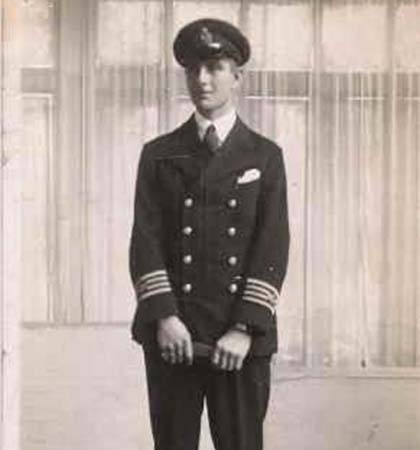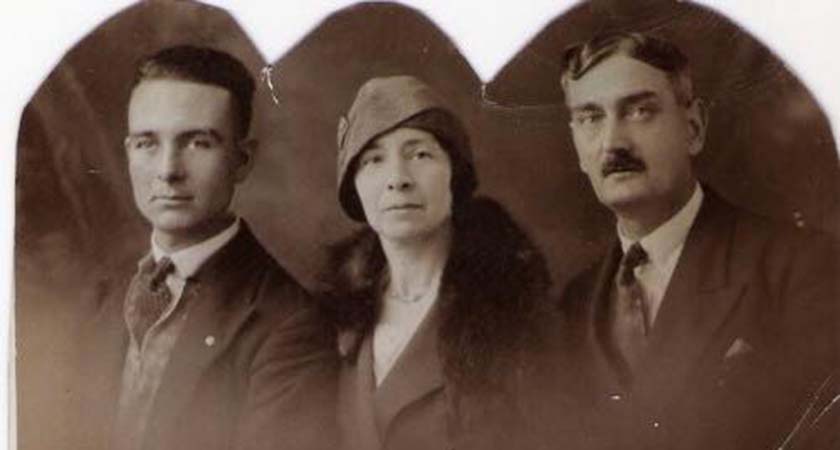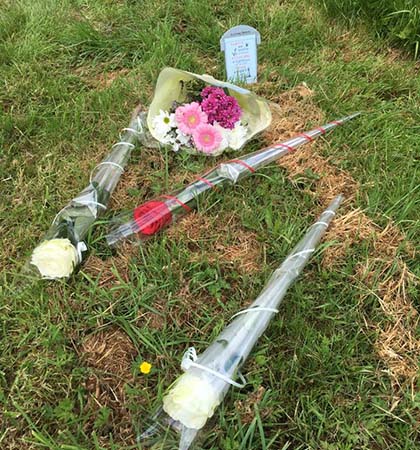THEY were the ship engineer brothers who left heartache behind when they disappeared without a trace from their family’s lives more than 60 years ago.
But unknown to their loved ones in London until this year, the lost Giggins brothers were heroes for their roles in a number of famous Irish shipping rescues.
Earlier this month, Wexford’s Friends of the Tall Ships sought fit to commemorate Eric and Roy Giggins for their brave work at sea.
The service held at Bride Street Church in Co. Wexford on 12th June, led to their families in the UK and Ireland who had no idea each other existed, meeting for the first time.
Sadly, Roy took his own life in the River Lee in 1981 and is buried in a pauper’s grave in Cork while Eric died three years later in Dublin. The families in the UK believed they were in Rotterdam until recently.
Roy’s 80-year-old daughter Betty Reilly, from Dartford travelled to Ireland this month to retrace her father’s steps after discovering he died there.
Betty along with her daughter Sharon Atlee and nephew Neil Deinhardt met their long lost cousins for the first time when they were presented with posthumous medals for Eric and Roy.
The meeting was described as a “dream” by Betty who never knew what became of her father and uncle that she loved so dearly.
She said: ‘My uncle Eric had a family London that I knew about but then he went on to have a second family in Ireland that none of us knew about.
‘I had such an emotional time in Ireland, meeting family for the first time having only found out about them a few months before. I still can't get over it really. I never thought I would ever find out what had happened to my father. Maybe I didn't try hard enough because I felt that he had abandoned my mother, me and my sister.
‘I felt a bit guilty that I perhaps hadn't had very strong feelings for him. This changed when we visited Ireland, and met the rest of the family and I felt very proud and honoured to receive his medal at the Seafarers Mass. I wonder what happened in those missing years?’
Heroes at sea
Betty’s uncle Eric was the Chief Engineer on the Co. Wexford coaster the MV Kerlogue during the most famous rescue mission in Irish Maritime history.
On 29th December 1943 he and nine other crewmen defied Ireland’s neutrality and bravely rescued 168 Germans from the Bay of Biscay after their ships were bombed the by the RAF.
Eric was the only British crewman on board and the rescue was described by writer Marie Claire McGann in her article MV Kerlogue at War: Serving Neither King Nor Fuehrer, But Humanity. He never spoke about the rescue which had a profound effect on the crewmen who spent 10 hours pulling wretched souls from the sea after 700 men were bombed.
They were forced to leave hundreds behind because of a lack of space and the ship was so packed that Eric Giggins couldn’t move around to operate his machinery, and so by sign language, because none of the men spoke English, he instructed them how to move his equipment and got the ship home that night.
Roy Giggins was also involved in a number of rescues on the Irish Menapia ship which was part of Stafford’s Steamship Company in Co. Wexford.
However, both men left Wexford in the fifties and moved to Dublin and Cork and lost contact with their former colleagues.
For the past ten years, the Wexford’s Friends of the Tall Ships committee tried to trace the families of the brothers.
Last year Eric’s family from Ardee Co. Louth turned up at the unveiling of a memorial by former lord Mayor of Wexford for the crewmen of the MV Kerlogue in the harbour.
Their attendance came after Eric’s granddaughter journalist Alison O’Reilly from Dublin began researching his life six years ago.
She has been working on a documentary about the Kerlogue for a number of years and is keen to contact any of the surviving Germans or their families.
‘It is the greatest rescue mission in Irish maritime history and those 10 men are heroes’ said Alison. ‘I’m very proud my grandfather is one of them. It is a story that needs to be told properly. I want to do that.
‘To think of what those Germans went through in the sea that night, the crew had to leave behind hundreds of young men that night because the Kerlogue couldn’t fit them onto their tiny boat. They died in the sea crying for their mothers. That must have had a profound effect on the crew who had to leave them behind as well as their families’
Eric and Roy's early lives
Born in Gravesend, London in 1908 to Evelyn Bruce and William Giggins, Eric Giggins who was the eldest of five, left his family in the 1930’s before moving to Ireland with his younger brother Roy.
The missing brothers worked in Norway and Rotterdam before settling in Wexford after being offered jobs with the Stafford’s Steamship Company.
The men, who were married with children in London, trained as mechanics before signing up to the shipping industry.
However, they made their final visit to London around 60 years ago and never returned and no explanation was ever given.
To this day, none of their families know why the men who were described as two of Ireland’s best-known ship engineers never came home.
Unknown to Eric’s family in London, he went on to have another family in Ireland after he met Mai Carolan from Ardee, Co. Louth in the early 1940’s.
Mai’s eldest daughter Margaret ‘Peggy’ Ramotar moved to London in the 1960’s and worked in Bexley hospital before settling in the area with her husband and children.
Unknown to Peggy, she worked alongside her half sister Wendy who was her father’s eldest daughter from his first marriage to Kathleen White.
After the Kerlogue rescue, Eric suffered with post-traumatic stress disorder and left Mai and her children however the couple never fell out and were in touch until he died.
Eric went on to work as an engineer on the Lady Gwendolyn at Guinness in Dublin while Roy moved to Arklow and Cork.
 Angela Laffan district manager,and Co. Wexford Mayor Ger Carty present a wreath to the children of Eric Giggins at the monument for the MV Kerlogue
Angela Laffan district manager,and Co. Wexford Mayor Ger Carty present a wreath to the children of Eric Giggins at the monument for the MV KerlogueEarlier this year, Betty made contact with her Irish family after distant relatives Robert and Merle Giggins in Australia made contact and passed on their details.
When Betty and her new cousin Eric Giggins junior went up to collect a medal on behalf of their long lost fathers at a ceremony in Ireland earlier this month, it finally brought closure to a sixty-year mystery.
‘It is like a dream’ she said. ‘My father didn’t even come home for his mother’s funeral. The last time I saw him was around about 1955 just before I got married but my memory of him was that he was a very smartly dressed good looking man.
‘My mother really loved him until the day she died and waited for him at every port when his ship docked. She just couldn’t hold him in the UK and we don’t know why’.
Betty’s father Roy left home when she was a child to work on the ships with his brother Eric.
He returned for Betty’s wedding to her husband Paddy Reilly when she was 20 but she never saw him again after that.
He left her mother Louisa and her younger sister Marie for good and cut all ties with the UK and so did his brother.
Betty said: ‘I believe that my father had it tough on the ships during the war along with his brother Eric and whatever the reason he could not face coming back to us in the UK which is really sad.
‘I heard many good things about him when I was over in Ireland and whilst there visiting his grave, the local pub and even people that worked with him,
‘I am so overwhelmed and happy to have found Roy Giggins and our new Giggins family in Ireland. Instead of a dead end when his name was mentioned, we can now say Roy Giggins a very smart, quiet man who was honoured and respected for the work he did during the war and who lays buried in the cemetery in Cork. I will never forget my trip to Ireland, it was emotional and wonderful at the same time. Visiting the cemetery, where he lived, where he worked and where he sadly died. It's been a very interesting journey.
Betty travelled to Cork to see her father’s grave for the first time and visited his former home on Myrtle Hill on the Lower Glanmire Road in Cork.
‘It helps that every single person I met spoke so highly of them. One fellow crewman Donal travelled from Cork to be at the mass for my father because was so kind to him’
Mary Hackett who runs the KLM bar in Tivoli, Co. Cork said Roy was a regular customer back in the eighties. ‘He was just the nicest man’ she said.
‘He worked on the Chocolate and Crumb boat and he would come in his snow white overalls. He was immaculate, he was very intelligent but he was quiet and private. There is a suggestion he had an problem with alcohol but I never would have thought that, Roy walked into the pub the same way he walked out. He was never drunk. He was a very kind man. He obviously suffered though because when you leave things too long it’s harder to go back to it. He probably thought “I’ve ruined my daughter’s lives and I can’t go back and face it”. That’s what happens to a lot of people, they leave things too long and then it becomes bigger than it is. His brother must have done the same. The men just kept running away from life’.
On 18th October 1981 Roy left the Port bar in Tivloi at around 9pm and said goodbye to the landlady Anne O’Connell.
She said: ‘He raised himself up on his toes over the crowd and said “goodnight Anne” I always remember seeing his face.
‘The next day the police came in and said Roy was found in the river. We were all in shock. I identified his body and I just couldn’t believe it. We went to his funeral the next day and he went into straight into a pauper’s grave, it all happened so fast he was being lowered into the ground before we even got to the grave. He was from London and I supposed the funeral directors thought no one would be coming to it. But it wasn’t like that, Roy was a gentleman, he obviously had troubles’.





